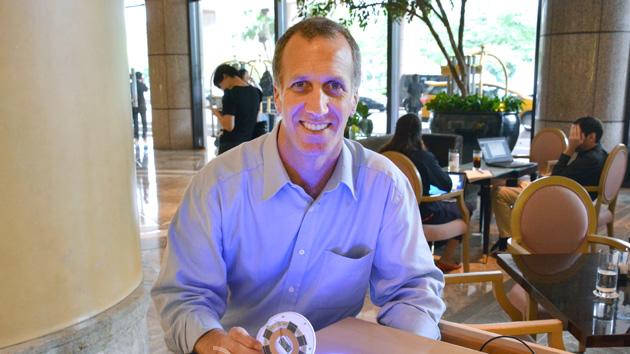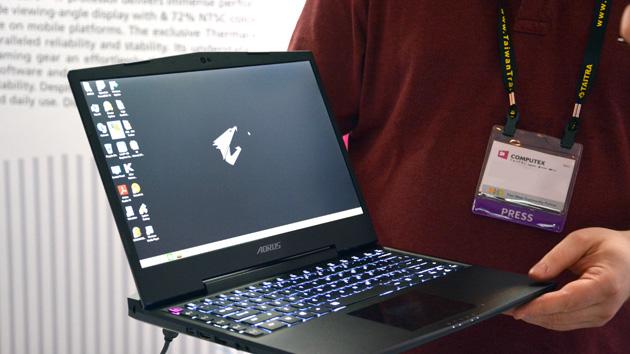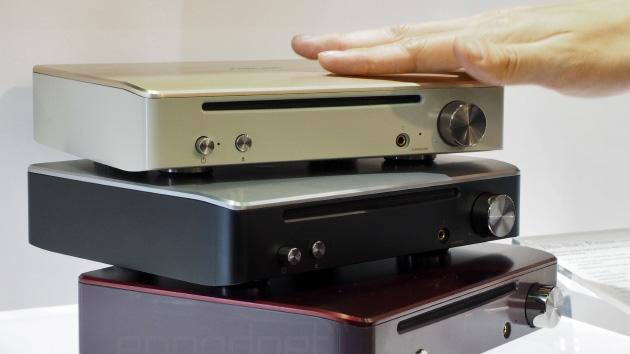computex2014
Latest

Intel's cable-free future will use WiTricity's advanced wireless charging
WiTricity will be implementing its resonance-based charging technology onto future Intel-powered devices, as according to the Rezence specification. Conveniently, WiTricity's newly appointed CEO, Alex Gruzen, is a veteran in the laptop industry.

HP's Leap Motion keyboard to be sold separately for $99
The Leap Motion controller is currently present in three forms: a $74.99 standalone dongle, inside the special edition HP Envy 17 laptop and inside an HP keyboard. The dongle -- with almost half a million units sold since launch -- and the keyboard are obviously the only ways to add this hand motion sensor externally, but the latter option was limited to select HP computers to begin with. Well, not any more. At Computex, Leap Motion told Engadget that as of this month, you'll be able to purchase said keyboard for about $99, and it'll work on any Windows 7 or Windows 8 PC as long as you have the software installed -- be it the current version or the free V2 update with skeletal tracking coming this summer.

Computex 2014 wrap-up: Intel and co. usher in the future of computing
For the last few years, we've travelled to Computex in Taiwan to see the latest flock of Ultrabooks, with the latest and greatest models providing the biggest news of the show. This year, though, the highlight of the show wasn't one particularly great notebook or even one company -- though ASUS did steal the show with its mile-long list of new products. Rather, it was a prototype from Intel that teased the next generation of ridiculously thin and light PCs.

Here's the world's 'most powerful and lightest' 13-inch gaming laptop
Following the impressive Razer Blade we reviewed last month, Gigabyte also wants a piece of the portable gaming laptop action with its new Aorus X3 line, a sub-14-inch Windows 8.1 device that claims to be the world's "most powerful and lightest" in its class. In terms of weight, it starts from 4.12 pounds (1.87kg), which is more attractive than the new Blade's 4.47 pounds (2.03kg). The smaller X3 has an impressive 13.3-inch QHD (2,560 x 1,440) LCD, whereas the larger 13.9-inch X3 Plus lets you choose between a QHD panel and a sweeter QHD+ (3,200 x 1,800) version.

Acer CEO: Better to make an imperfect smartwatch than none at all
Acer is in trouble, but that's not Jason Chen's fault. The CEO, who's only been on the job five months, inherited an organization besieged by a shrinking PC market and record losses. So how is he doing? Too soon to say, really, but there are signs Acer might be turning over a new leaf: The company this week unveiled a tablet, a bunch of smartphones and its first smartwatch, the Liquid Leap. No PCs, though. If nothing else, it's clear the firm is eager to branch out beyond cheap laptops.

Baby steps toward better wearables at Computex 2014
Google's latched on to Diane von Fürstenberg as the solution for making Glass fashion-forward, unveiling a collection of frames made by the famed Belgian designer last week. While it remains to be seen whether trendy-colored frames can make a $1,500 wearable more appealing, a few smaller companies here at Computex in Taiwan have some novel ideas that could make you more willing to strap a mini-computer on your face... or your wrist.

Angry owl is angry: ASUS does a badass gaming headset
When ASUS announced its new mainstream gaming sub-brand Strix two weeks ago, it also unveiled the Strix Pro gaming headset which, to be frank, didn't look that good in the official renders. Luckily, we stumbled across the real deal at Computex, and its glowing orange owl eyes immediately got us fixated on them. These cans feature a "thunderous" 60mm neodymium-magnet driver in each side, and they're further enhanced by noise cancellation -- enabled by the USB control box -- that's apparently over 90 percent effective. Conveniently, the microphone boom is detachable, so that you can use the headset as a normal pair of headphones.

Asia's biggest tech show is ASUS' show
While covering Computex 2014 this year, we saw ASUS Chairman Jonney Shih take to the stage no less than three times. Granted, two were to showcase his company's seemingly limitless product launches, but he also snuck on stage at Intel's keynote -- arguably the only other company that makes an impact at the Taipei trade show. ASUS is a Taiwanese company and when Shih appears, several lines of journalists pop up (as do their flashes), and the light show pretty much continues until he leaves -- the home crowd likes him. It also helps that the chairman comes across as super enthused whenever he talks up the products -- we can recall a particularly cheerful "ubiquitous cloud computing" exclamation at last year's showcase. There's also the fact that ASUS exceeds even Samsung when it comes to producing previously unseen form factors. From phone tablets to tablet phones to hybrids and, this year, a "five-in-one" PC with a built-in smartphone. After a relentless flurry of announcements, journalists, analysts and bloggers are then unleashed into smallish demo areas, where, if you're lucky, there are two of the new, flashy devices to share around a room of hundreds. Apple events might carry a higher degree of pressure, but the chaos of an ASUS press launch at Computex remains... unique. Here's how ASUS made this Taipei tech event its own.

Intel: Where we're going, we don't need cables
If you ask us, Intel's "Llama Mountain" design -- a PC even thinner than the iPad -- is already pretty futuristic. "Futuristic" might be an inaccurate word, though, considering that thing (or devices like it) will arrive later this year. No, if you want futuristic, you'll have to look toward Intel's next-next-generation chips, slated to debut sometime in 2015. A couple years from now, PCs might be missing cables, ports and even passwords -- not that Intel gets much of a say on that last one.

Intel's super-thin 'Core M' tablets will be cheaper than you think
It's OK if you're not a chip geek: All you need to know is that Intel's 7.2mm-thick reference PC was the most important thing we saw this week at Computex. Designed for 2-in-1s, the company's Core M-series processors will usher in full-fledged computers that are even skinnier than the iPad Air. Exciting, right? Seriously -- and maybe you just have to see for yourself -- these things are impressive. Futuristic, even. Given that, then, we would have assumed they'd hit the market later this year with steep prices in tow. After all, aren't we used to paying a premium for thin?

Toshiba stuffs Windows into a 7-inch tablet, whether you want it or not
There's no shortage of 8-inch Windows tablets on the market right now, but Microsoft and its partners are pushing ahead with plans to shrink the OS even further. A Redmond executive at Computex has just shown off the Toshiba Encore 7: a 7-inch tablet running full Windows 8.1. If you're thinking that the Windows desktop will be mighty fiddly at this screen size, then you're right -- it's only going to be useful as a Plan B when there's no other way to get into a legacy application, or when you're hooked up to a keyboard, mouse and bigger display. For regular use, you'd be reliant on the more thumb-friendly Metro UI and apps.

The PhoneStation uses your smartphone as a head-mounted display
You'll find plenty of knockoff wearables at a trade show like Computex, but there are always a few gems mixed in among the boring copycats. Exhibit A: View Phone Technology, a little-known Taiwanese company, is showing off a head-mounted 3D display that puts content from your phone directly before your eyes. The aptly named PhoneStation converts video to 3D, letting you use any handset to stream movies and TV shows directly from YouTube.

E Ink's working on a smartwatch with a full wraparound display
E Ink's perhaps best known for its e-reader displays, such as the Pearl used in Amazon's Kindle Paperwhite, but the company's black-and-white panels can also be found in a variety of smartwatches, from manufacturers such as Archos, Phosphor and Seiko. Most of these are simply traditional wristwatches with small, low-power screens, but an upcoming model could have a much larger curved display that covers the majority of the wearable's footprint, according to company representatives we spoke with at Computex. Such a device would have a panel that stretches from one end to the other, letting you change the entire watch's design just as you would the face on devices available today.

This $295 battery-powered unicycle could replace your Segway
Ah, the sweet memory of learning to ride a bike with training wheels! My hands are sweaty, and my ego a bit damaged after spending a half-hour learning to ride a battery-powered unicycle called the Pinwheel. This $295 (wholesale) gadget is one of the more interesting finds here at Computex 2014 -- if you've been looking to ditch that Segway for a more portable mode of transport, this may be it. It's made by Shenzhen-based company TOPJOY, and it really is a thrill to ride.

An up close look at the giant gaming PC that's also a desk
Lian Li usually deals in computer towers, but it occasionally dabbles in incredible (or mad) desks built specifically to house desktop PCs. We even got to see one of these monstrosities in person, the top-end model above, spotted right in the epicenter of Computex, Asia's biggest tech show. Given the trend toward tablets, phones and wearables this year, it could well be the most... Computex thing here. We just wish there was some kind of award for that.

Watch strap batteries could double the life of your wearable
Smartwatches are starting to look a whole lot better, but they're still liable to run out of juice in mere days. A flexible-battery manufacturer here at Computex reckons its thin, flexible lithium-ceramic cells, shaped into wristbands, could offer as much as 500mAh of extra power, with existing models already offering an extra 300mAh. According to ProLogium, that would effectively double the battery of Pebble's smartwatch and, well, on-paper specifications suggest that it could more than double the capacity.

HP's Pro x2 612 laptop-tablet hybrid brings pen support, a sturdy keyboard
If you read our Surface Pro 3 review, you know we recommend it, but only for a certain kind of person: someone who needs both a laptop and a tablet, preferably one that allows for pen input. Even then, is Microsoft's approach the smartest one? Can you really call something a laptop replacement if it's not as comfortable to use in the lap, or if the keyboard isn't as sturdy? For all of you skeptics out there, there's an alternative incoming: HP has just announced the Pro x2 612, a laptop-tablet hybrid that offers many of the same features as the Surface Pro 3. Like the Surface, this is a 12-inch tablet that supports pen input and runs on Ultrabook-caliber Intel Core processors. The main difference is that rather than use a flat, click-in keyboard, the Pro x2 612 comes with a backlit, spill-resistant keyboard dock. As a bonus, that dock also includes a spare battery that brings the total runtime to about 14 hours.

ASUS shows off a 14-inch USB touchscreen monitor
ASUS is demoing quite a few alleged "world firsts" at its Computex booth. In addition to a 32-inch curved LED monitor, there's a 14-inch USB touch monitor on hand here in Taipei. We're used to seeing USB monitors here -- ASUS had one at this same venue last year, actually -- but the addition of touch is definitely the standout feature this time around.

ASUS' new external Blu-ray drive does 7.1 audio at a fair price
While ASUS continues to impress us with a slew of PCs and mobile devices at Computex, let's not forget that it still makes some nice peripherals. One thing that surprised us at the ASUS booth was a pretty external Blu-ray drive aimed at audio buffs. Dubbed the Blu-ray Prime, this USB 3.0 device claims to be the "world's only optical drive with 7.1-channel audio output," courtesy of the integrated ASUS Xonar sound card, which packs a Cirrus Logic CS4398 DAC and a C-Media CM6631A audio processor, plus optical output. It also features a 600-ohm headphone amplifier and a clean 114dB signal-to-noise ratio. Expect the Blu-ray Prime to hit various markets for about $199 in Q4, after the DVD version is released in Q3 for half the price. Photos by Zach Honig.

ASUS introduces us to the 'world's largest' curved LED monitor
ASUS announced a slew of high-profile devices at its press conference yesterday, but the company's booth at Computex still turned up a few gems today. Among them: a prototype of a 32-inch curved LED monitor, which ASUS says is the largest of its kind.





